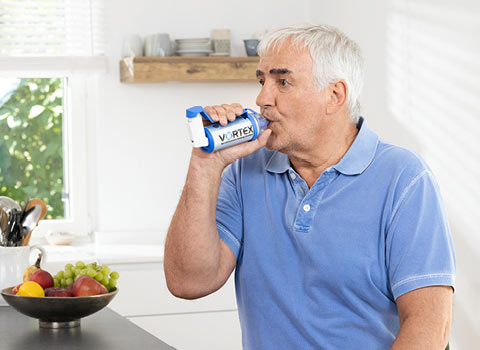COPD affects 4-10 % of the population, varying by country. Globally, it’s a top-three cause of death, claiming three million lives annually. Despite its prevalence, COPD is both preventable and treatable, albeit irreversible.
Many patients are diagnosed in late stages of COPD. This is because they seek out a respiratory specialist when the symptoms become unignorable to them which is usually the case in later stages of the disease. Those patients often extensively suffer from concomitant comorbidities and symptoms.
Advantage
No hand-breath coordination required.
Challenge
Requires sufficient inspiratory flow and sufficient cognitive and physical skills.
Advantage
Suitable for patients with low inspiratory flow since MDIs require slow, deep breathing.
Challenge
Actuating the MDI and inhaling at the same time can be challenging. Sufficient coordination and hand strength is a prerequisite. Holding chambers can facilitate effective inhalation.
Advantage
No special breathing technique necessary as the natural breathing is sufficient.
No hand-breath coordination necessary.
Challenge
Longer inhalation times than with MDIs or DPIs.
If the peak inspiratory flow (PIF) of a patient is not sufficient to use a DPI, a MDI should be used. This characteristic is quite common amongst COPD patients. More than 50 % of COPD patients currently experiencing exacerbation had suboptimal PIF [1][2], while 1 out of 5 outpatients with severe COPD did not achieve optimal PIF for DPI [3].
Patients with suboptimal PIF should rather use a MDI instead of a DPI. Up to 87 % of COPD patients make at least one inhaler technique error [4]. Additionally, many COPD patients suffer from cognitive impairment and diminishing coordination abilities.
Using MDIs with holding chambers requires less hand-breath coordination and provides an easy solution. If the hand strength is weak a holding chamber with a one-handed operation aid should be considered.

Inhaler mishandling is frequent and associated with increased severe COPD exacerbation [5]. The GOLD Report 2024 recommends considering nebulisers if other inhalers have not worked [6]. Nebulisers may be beneficial for patients with inadequate symptom relief despite appropriate use of inhalers or for those with compliance issues [7].
In general patients with severe to very severe COPD and / or reduced cognitive and physical abilities can benefit from being given a nebuliser [7].
Especially in smokers, mucus overproduction in the airways is frequently observed in COPD which worsens the obstruction and negatively impairs mucociliary clearance [8]. A recently published retrospective observational study has shown that mucus plugs that block medium to large airways are associated with increased mortality in COPD patients [9].
Therefore rehydration of the mucus layer is considered a valid approach in muco-obstructive diseases [10]. Nebulised hypertonic saline solution promotes the self-cleaning function of the lungs and can help to clear excess mucus.
It’s as simple as it sounds but one should consider asking the patient. A study showed that patients and their caregivers preferred nebuliser treatment over other devices due to ease of use, better overall symptom control and long-term relief [11].

In case that nebuliser therapy is indicated the actual Nice Guidelines (2019) for the diagnosis and treatment of COPD recommends using a nebuliser that is known to be efficient [12]. Efficiency can objectively be measured by the RDDR (Respirable Drug Delivery Rate). A publication points out that there are major differences between nebuliser systems in terms of efficiency [13]. PARI nebulisers are well ahead of the market in terms of RDDR.
References
[1] Loh et al. Ann Am Thorac Soc Vol 14, No 8, pp 1305-1311, Aug 2017.
[2] Broeders et al. Respir Med. 2004;98:1173-1179.
[3] Mahler et al. J Aerosol Med Pulm Drug Deliv 2013;26:174-179.
[4] Cho-Reyes et al. Chronic Obstr Pulm Dis. 2019;6(3):267-80.
[5] Molimard, M., et al. European Respiratory Journal, 2017. 49(2): p. 1601794.
[6] Gold Report 2024.
[7] Dhand et al. COPD: Journal of Chronic Obstructive Pulmonary Disease 2012; 9(1):58-72.
[8] Dunican et al. Am J Respir Crit Care Med. 2021;203(8):957-68.
[9] Diaz AA et al. JAMA. 2023;329(21):1832-9.
[10] Boucher RC. N Engl J Med. 2019;380(20):1941-53.
[11] Dumra et al. International Journal of Chronic Obstructive Pulmonary Disease 2022:17;2277-2288.
[12] National Institute for Health and Care Excellence (NICE). Chronic obstructive pulmonary disease in over 16s: diagnosis and management. 2019.
[13] Fischer et al. Journal of Aerosol Medicine and Pulmonary Drug Delivery, 2022. 36(3): p. 116.
Contact us on supporting studies, clinical cases, scientific information on RDDR as well as PARI nebulisers and VORTEX holding chamber.
Contact us
Any questions? You can reach our service center at this number:
+49 8151 279-5220
International Distribution Partners
If you are looking to buy PARI products in a specific country, please click here
© 2025 PARI GmbH Spezialisten für effektive Inhalation